TOYOTA PROACE VERSO 2020 Manual Online
Manufacturer: TOYOTA, Model Year: 2020, Model line: PROACE VERSO, Model: TOYOTA PROACE VERSO 2020Pages: 418, PDF Size: 39.32 MB
Page 81 of 418
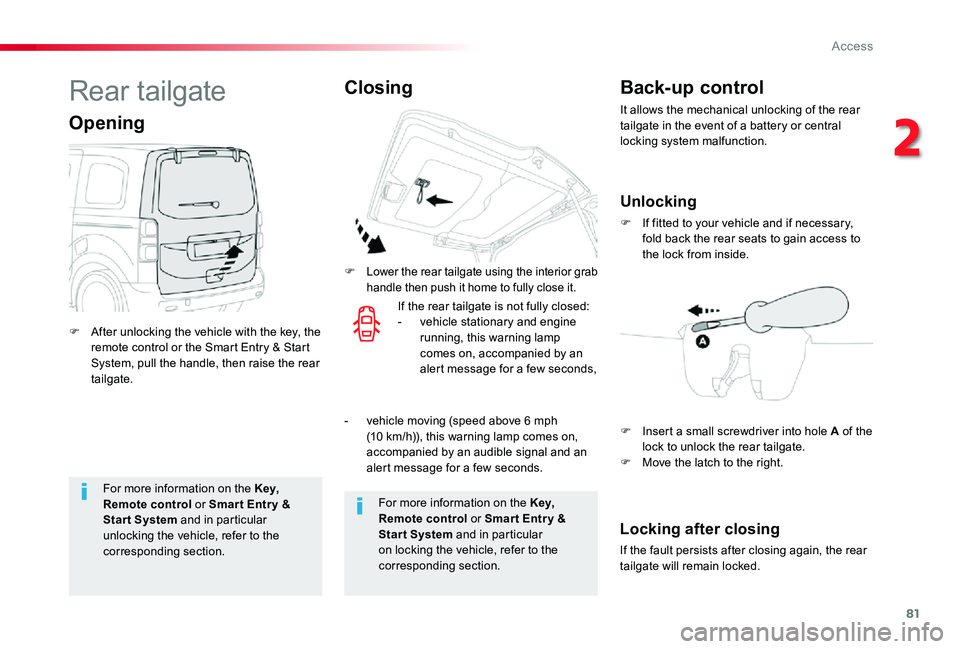
81
For more information on the Key, Remote control or Smar t Entr y & Start System and in particular unlocking the vehicle, refer to the corresponding section.
For more information on the Key, Remote control or Smar t Entr y & Start System and in particular on locking the vehicle, refer to the corresponding section.
Rear tailgate
F After unlocking the vehicle with the key, the remote control or the Smart Entry & Start System, pull the handle, then raise the rear tailgate.
Opening
F Lower the rear tailgate using the interior grab handle then push it home to fully close it.
ClosingBack-up control
It allows the mechanical unlocking of the rear tailgate in the event of a battery or central locking system malfunction.
Unlocking
F If fitted to your vehicle and if necessary, fold back the rear seats to gain access to
the lock from inside.
Locking after closing
If the fault persists after closing again, the rear tailgate will remain locked.
If the rear tailgate is not fully closed:- vehicle stationary and engine running, this warning lamp comes on, accompanied by an alert message for a few seconds,
F Insert a small screwdriver into hole A of the lock to unlock the rear tailgate.F Move the latch to the right.
- vehicle moving (speed above 6 mph (10 km/h)), this warning lamp comes on, accompanied by an audible signal and an alert message for a few seconds.
2
Access
Page 82 of 418
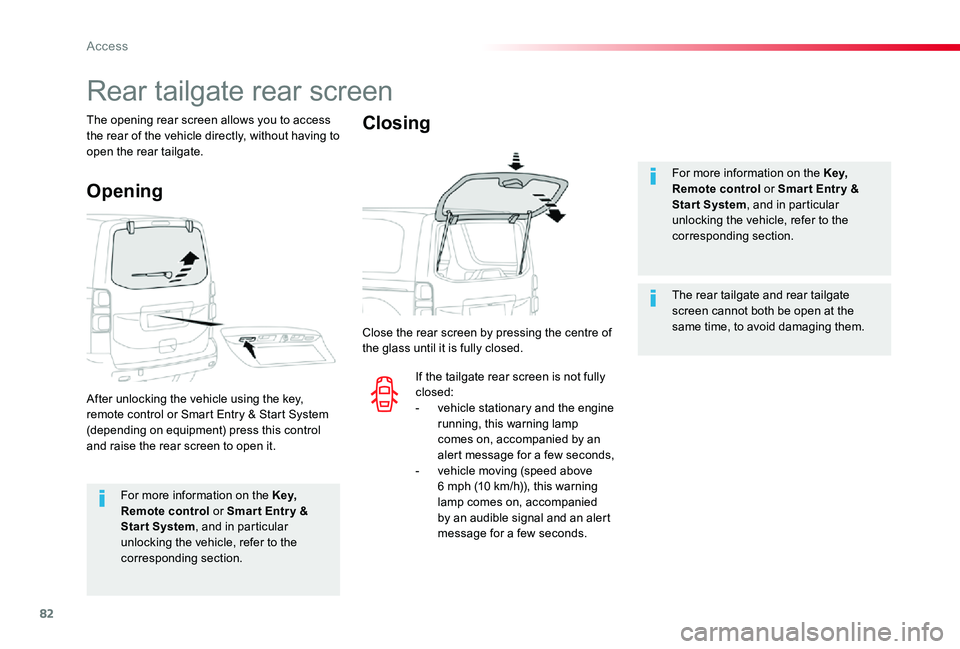
82
For more information on the Key, Remote control or Smar t Entr y & Start System, and in particular unlocking the vehicle, refer to the
corresponding section.
For more information on the Key, Remote control or Smar t Entr y & Start System, and in particular unlocking the vehicle, refer to the corresponding section.
The rear tailgate and rear tailgate screen cannot both be open at the same time, to avoid damaging them.
Rear tailgate rear screen
The opening rear screen allows you to access the rear of the vehicle directly, without having to open the rear tailgate.
Opening
Closing
After unlocking the vehicle using the key, remote control or Smart Entry & Start System (depending on equipment) press this control
and raise the rear screen to open it.
Close the rear screen by pressing the centre of the glass until it is fully closed.
If the tailgate rear screen is not fully closed:- vehicle stationary and the engine running, this warning lamp comes on, accompanied by an alert message for a few seconds,- vehicle moving (speed above 6 mph (10 km/h)), this warning lamp comes on, accompanied by an audible signal and an alert message for a few seconds.
Access
Page 83 of 418
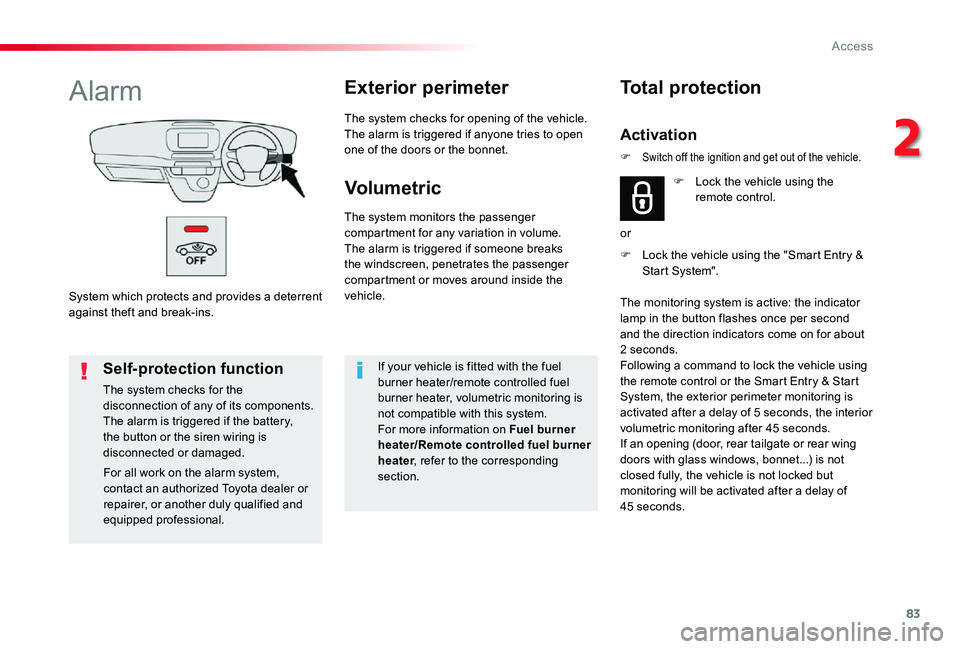
83
System which protects and provides a deterrent against theft and break-ins.
AlarmExterior perimeter
The system checks for opening of the vehicle.The alarm is triggered if anyone tries to open one of the doors or the bonnet.
Self-protection function
The system checks for the disconnection of any of its components.The alarm is triggered if the battery, the button or the siren wiring is disconnected or damaged.
For all work on the alarm system, contact an authorized Toyota dealer or repairer, or another duly qualified and equipped professional.
Volumetric
The system monitors the passenger compartment for any variation in volume.The alarm is triggered if someone breaks the windscreen, penetrates the passenger compartment or moves around inside the vehicle.
If your vehicle is fitted with the fuel burner heater/remote controlled fuel burner heater, volumetric monitoring is not compatible with this system.For more information on Fuel burner heater/Remote controlled fuel burner heater, refer to the corresponding section.
F Lock the vehicle using the "Smart Entry & Start System".
Total protection
Activation
F Lock the vehicle using the remote control.
or
The monitoring system is active: the indicator lamp in the button flashes once per second and the direction indicators come on for about 2 seconds.Following a command to lock the vehicle using the remote control or the Smart Entry & Start System, the exterior perimeter monitoring is activated after a delay of 5 seconds, the interior volumetric monitoring after 45 seconds.If an opening (door, rear tailgate or rear wing doors with glass windows, bonnet...) is not closed fully, the vehicle is not locked but monitoring will be activated after a delay of 45 seconds.
F Switch off the ignition and get out of the vehicle.
2
Access
Page 84 of 418
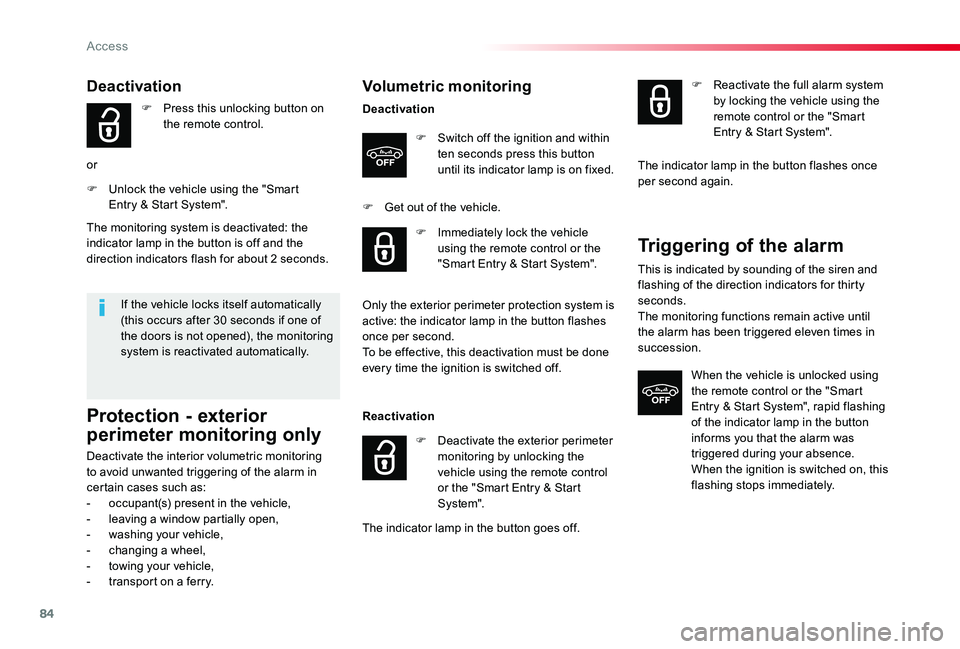
84
Volumetric monitoring
Deactivation
F Switch off the ignition and within ten seconds press this button until its indicator lamp is on fixed.
F Get out of the vehicle.
Reactivation
The indicator lamp in the button goes off.
F Immediately lock the vehicle
using the remote control or the "Smart Entry & Start System".
Only the exterior perimeter protection system is active: the indicator lamp in the button flashes once per second.To be effective, this deactivation must be done every time the ignition is switched off.
F Deactivate the exterior perimeter monitoring by unlocking the vehicle using the remote control or the "Smart Entry & Start S ystem".
F Reactivate the full alarm system by locking the vehicle using the remote control or the "Smart Entry & Start System".
The indicator lamp in the button flashes once per second again.
Triggering of the alarm
This is indicated by sounding of the siren and flashing of the direction indicators for thirty seconds.The monitoring functions remain active until the alarm has been triggered eleven times in succession.
When the vehicle is unlocked using the remote control or the "Smart Entry & Start System", rapid flashing of the indicator lamp in the button informs you that the alarm was triggered during your absence.When the ignition is switched on, this flashing stops immediately.
Deactivation
F Press this unlocking button on the remote control.
or
F Unlock the vehicle using the "Smart Entry & Start System".
If the vehicle locks itself automatically (this occurs after 30 seconds if one of the doors is not opened), the monitoring system is reactivated automatically.
The monitoring system is deactivated: the indicator lamp in the button is off and the direction indicators flash for about 2 seconds.
Protection - exterior
perimeter monitoring only
Deactivate the interior volumetric monitoring to avoid unwanted triggering of the alarm in certain cases such as:- occupant(s) present in the vehicle,- leaving a window partially open,- washing your vehicle,- changing a wheel,- towing your vehicle,- transport on a ferry.
Access
Page 85 of 418
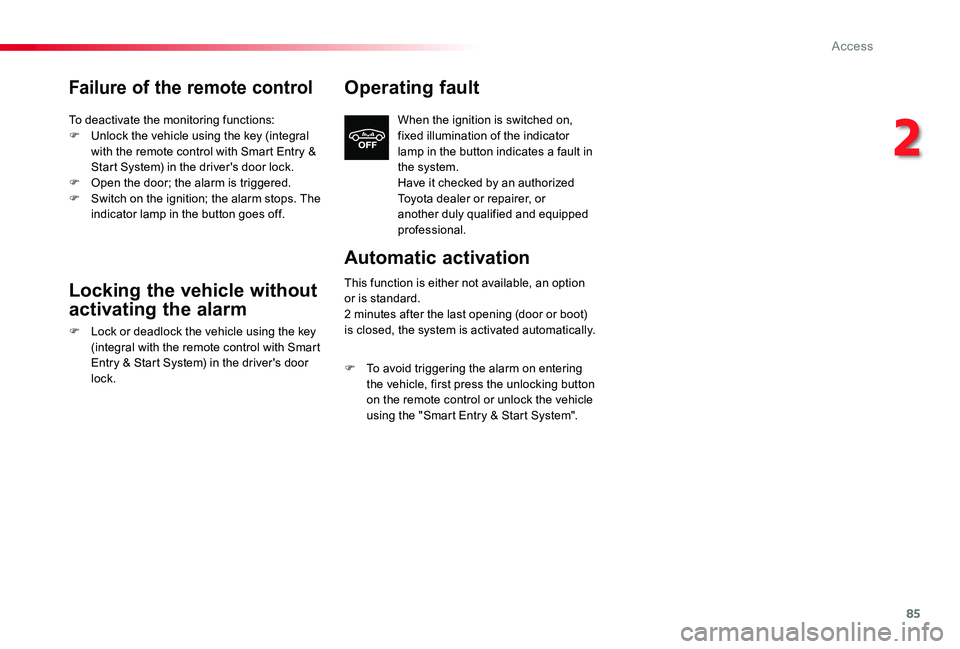
85
Failure of the remote control
To deactivate the monitoring functions:F Unlock the vehicle using the key (integral with the remote control with Smart Entry & Start System) in the driver's door lock.F Open the door; the alarm is triggered.F Switch on the ignition; the alarm stops. The indicator lamp in the button goes off.
Locking the vehicle without
activating the alarm
F Lock or deadlock the vehicle using the key (integral with the remote control with Smart Entry & Start System) in the driver's door lock.
Operating fault
When the ignition is switched on, fixed illumination of the indicator lamp in the button indicates a fault in the system.Have it checked by an authorized Toyota dealer or repairer, or another duly qualified and equipped professional.
Automatic activation
This function is either not available, an option or is standard.2 minutes after the last opening (door or boot) is closed, the system is activated automatically.
F To avoid triggering the alarm on entering the vehicle, first press the unlocking button on the remote control or unlock the vehicle using the "Smart Entry & Start System".
2
Access
Page 86 of 418
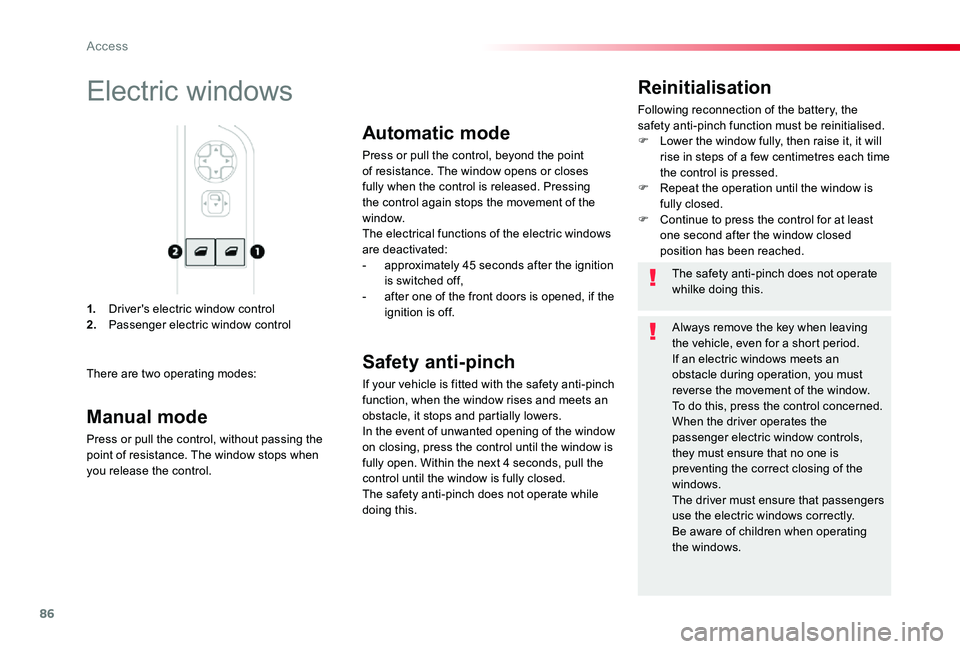
86
1. Driver's electric window control2. Passenger electric window control
Reinitialisation
Following reconnection of the battery, the safety anti-pinch function must be reinitialised.F Lower the window fully, then raise it, it will rise in steps of a few centimetres each time the control is pressed.F Repeat the operation until the window is fully closed.F Continue to press the control for at least one second after the window closed position has been reached.
Electric windows
There are two operating modes:
The safety anti-pinch does not operate whilke doing this.
Always remove the key when leaving the vehicle, even for a short period.If an electric windows meets an obstacle during operation, you must reverse the movement of the window. To do this, press the control concerned.When the driver operates the passenger electric window controls, they must ensure that no one is preventing the correct closing of the windows.The driver must ensure that passengers use the electric windows correctly.Be aware of children when operating the windows.
Manual mode
Press or pull the control, without passing the
point of resistance. The window stops when you release the control.
Automatic mode
Press or pull the control, beyond the point of resistance. The window opens or closes fully when the control is released. Pressing the control again stops the movement of the window.The electrical functions of the electric windows are deactivated:- approximately 45 seconds after the ignition is switched off,- after one of the front doors is opened, if the ignition is off.
Safety anti-pinch
If your vehicle is fitted with the safety anti-pinch function, when the window rises and meets an obstacle, it stops and partially lowers.In the event of unwanted opening of the window on closing, press the control until the window is fully open. Within the next 4 seconds, pull the control until the window is fully closed.The safety anti-pinch does not operate while doing this.
Access
Page 87 of 418
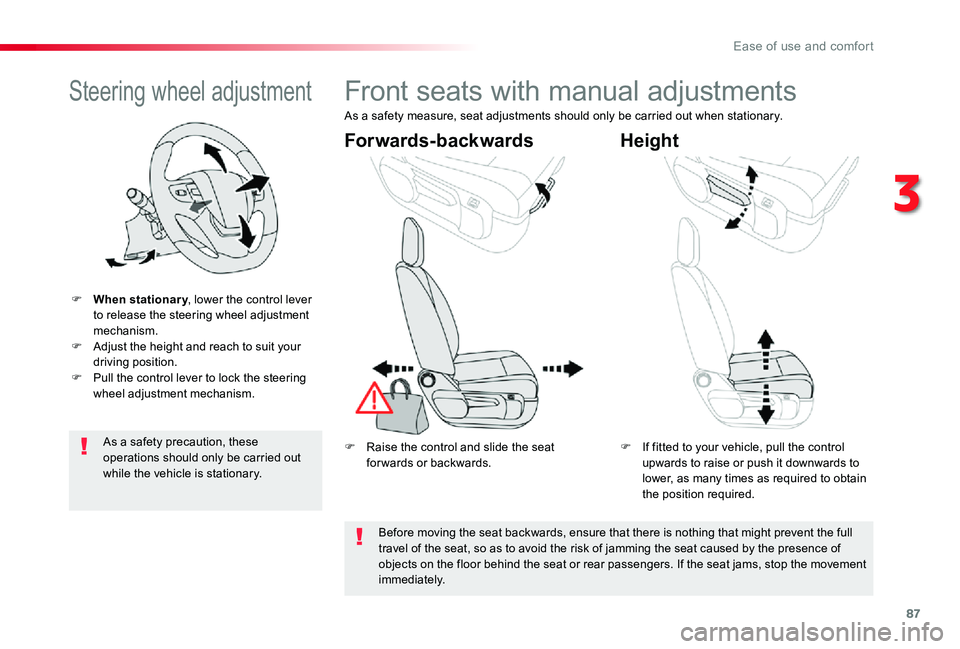
87
Steering wheel adjustment
F When stationary, lower the control lever to release the steering wheel adjustment mechanism.F Adjust the height and reach to suit your driving position.F Pull the control lever to lock the steering wheel adjustment mechanism.
As a safety precaution, these
operations should only be carried out while the vehicle is stationary.
Front seats with manual adjustments
F Raise the control and slide the seat for wards or backwards.F If fitted to your vehicle, pull the control upwards to raise or push it downwards to lower, as many times as required to obtain the position required.
Forwards-backwardsHeight
As a safety measure, seat adjustments should only be carried out when stationary.
Before moving the seat backwards, ensure that there is nothing that might prevent the full travel of the seat, so as to avoid the risk of jamming the seat caused by the presence of objects on the floor behind the seat or rear passengers. If the seat jams, stop the movement immediately.
3
Ease of use and comfort
Page 88 of 418
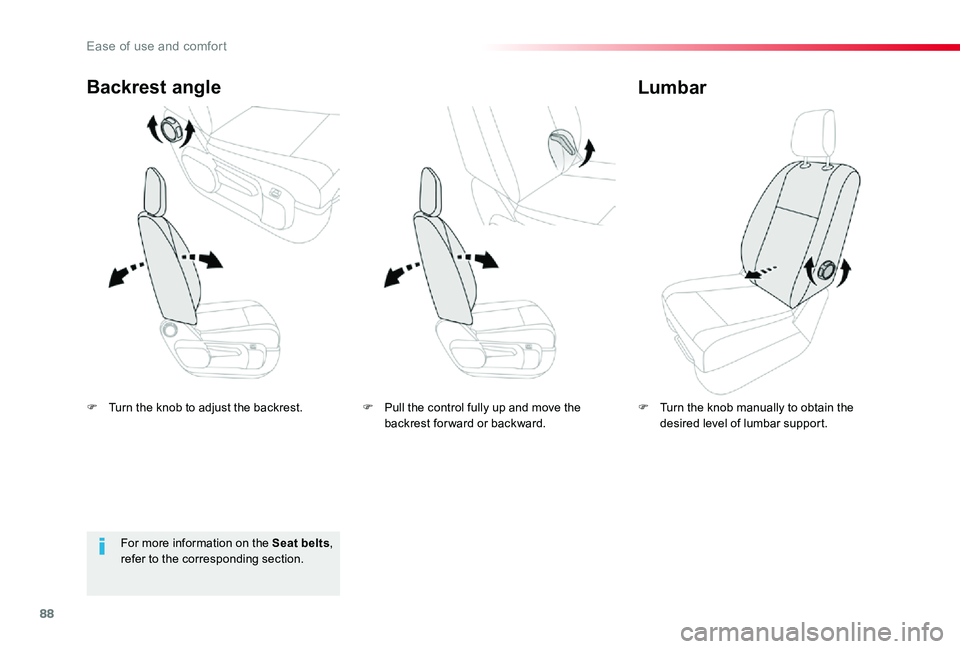
88
F Turn the knob to adjust the backrest.
Backrest angle
F Turn the knob manually to obtain the desired level of lumbar support.
Lumbar
For more information on the Seat belts, refer to the corresponding section.
F Pull the control fully up and move the backrest for ward or backward.
Ease of use and comfort
Page 89 of 418
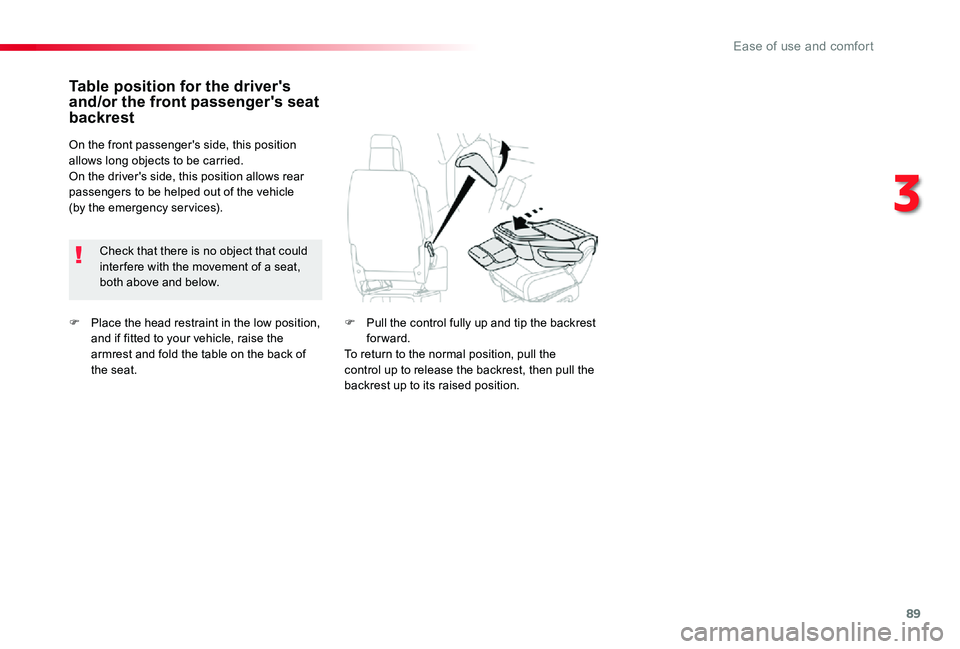
89
F Place the head restraint in the low position, and if fitted to your vehicle, raise the armrest and fold the table on the back of the seat.
Table position for the driver's and/or the front passenger's seat backrest
Check that there is no object that could inter fere with the movement of a seat, both above and below.
On the front passenger's side, this position allows long objects to be carried.On the driver's side, this position allows rear passengers to be helped out of the vehicle (by the emergency services).
F Pull the control fully up and tip the backrest forward.To return to the normal position, pull the control up to release the backrest, then pull the backrest up to its raised position.
3
Ease of use and comfort
Page 90 of 418
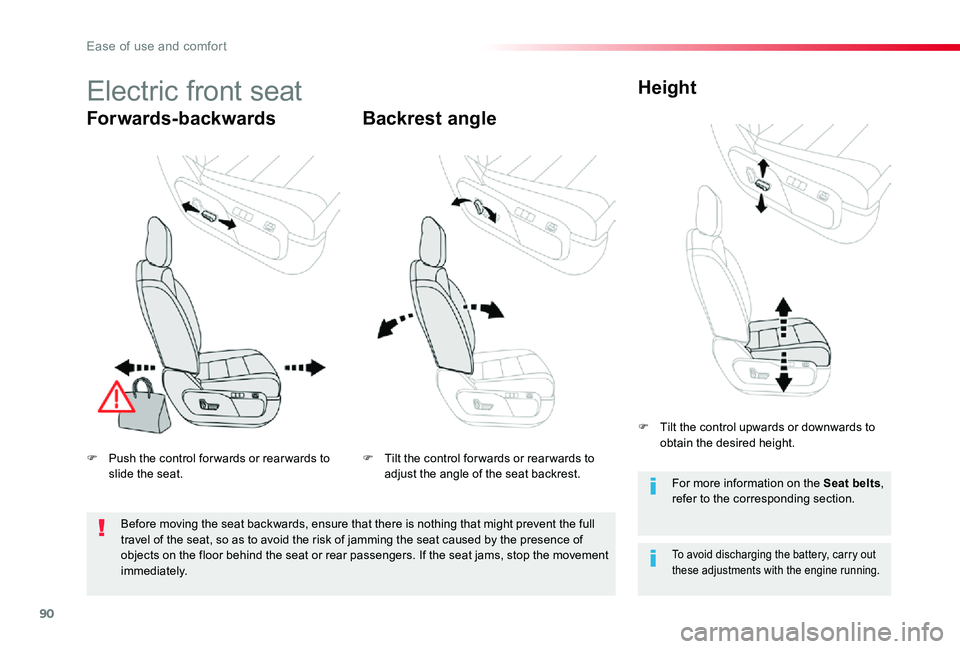
90
Electric front seat
Forwards-backwardsBackrest angle
Height
To avoid discharging the battery, carry out these adjustments with the engine running.
F Push the control for wards or rear wards to slide the seat.F Tilt the control for wards or rear wards to adjust the angle of the seat backrest.
F Tilt the control upwards or downwards to obtain the desired height.
Before moving the seat backwards, ensure that there is nothing that might prevent the full travel of the seat, so as to avoid the risk of jamming the seat caused by the presence of objects on the floor behind the seat or rear passengers. If the seat jams, stop the movement immediately.
For more information on the Seat belts, refer to the corresponding section.
Ease of use and comfort